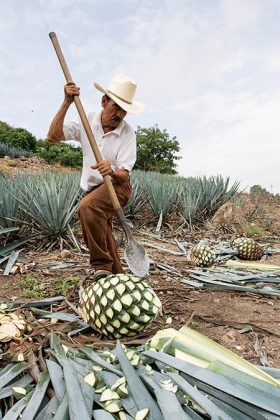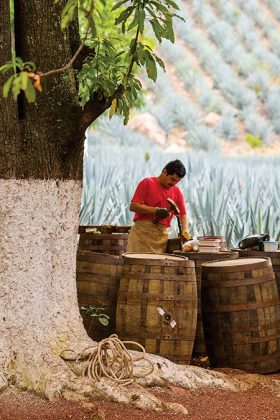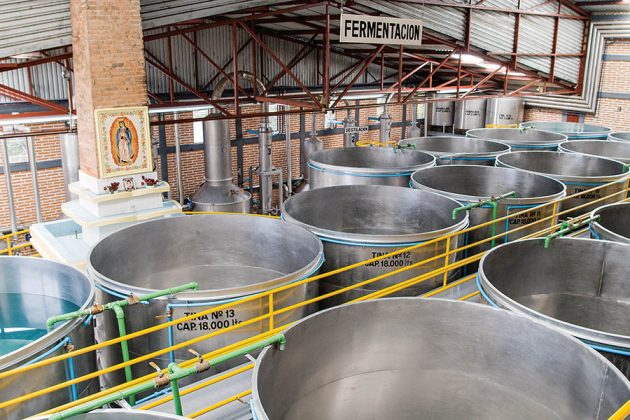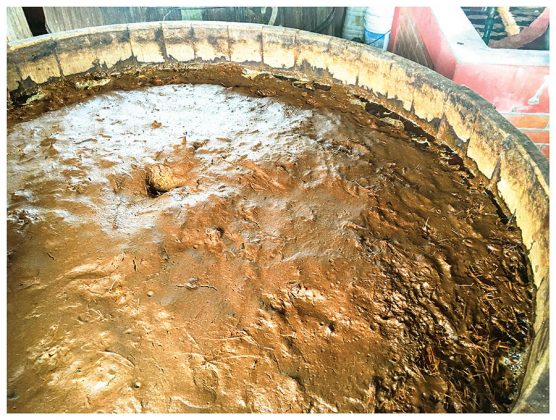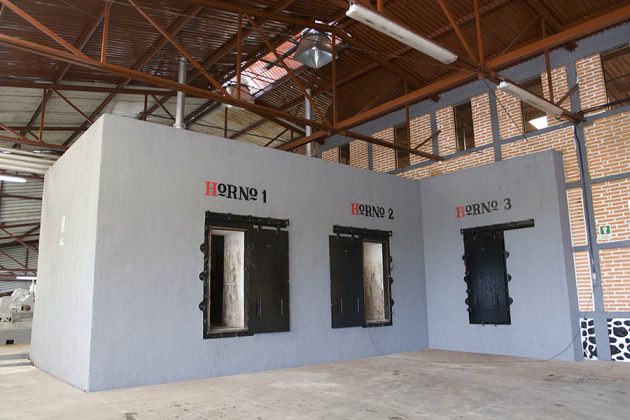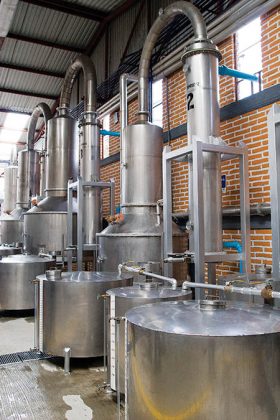When driving through the deserts connecting the regions in Mexico where mezcal and tequila are produced, the landscape shows many similarities between the two areas, including the cacti dotting the rolling desert hills into the distance. Of the many differences separating the two however, the tequila region features huge areas with neat rows of agave, running up and down hills far into the distance. Behind those hills though, the tequila industry is relatively modern, while mezcal producers have changed their methods very little—dating back to the time of the 16th-century conquistadores.
In the Mexican state of Jalisco, the Blue Weber agave (Agave tequilana), is often cultured in careful rows, with whole hills denuded in a harvest cycle every 7–10 years as a crop is ready for processing into tequila. However, in the state of Oaxaca where mezcal is made, cultivated agave fields still raise some interest because it is a relatively new advent. “I wonder whose plants those are?” is a common comment. While for decades the much larger tequila industry has been growing massive farms of Blue Weber agave, the tradition in Oaxaca for hundreds of years is that mezcaleros have harvested agave, most often the Espadin (Agave angustifolia) variety, from the wild and watched individual succulents (not cacti), waiting until the perfect moment when they were ready.
It could be said, these differences are just the first dissent between these familial industries currently creating so much of a stir in bars amongst the startender-class, and in the boardrooms of the conglomerates who now are racing up and down the Oaxacan mountains, looking for brands and palenques (distilleries) to add to their stable. These differences are incredibly obvious: In Jalisco, distilleries are a mix of beautiful tourist vacation destinations and heavy-industrial centers. As opposed to in Oaxaca, where you see small earthen brick buildings on the side of the roads or way up secluded mountains, each a palenque, owned by a family for years or often generations. This is not even the starkest differentiation between these two related industries. How the agave is processed? Well, that’s another tale.
Mezcal: With the conquistadores came to the New World many challenges for the native peoples living in what is today Mexico. One thing that came with them though was the advent of the copper alembic, a technology still used today, unchanged for five hundred years, used to create the style of alcohol called mezcal
(/mɛsˈkæl/). Named after Nahuatl words meaning “oven-cooked agave,” how the agave is cooked is the center of the defining characteristic for the differences between mezcal and…
Tequila: Having a much more convoluted history, tequila was granted Appellation of Origin in 1978, but in its general modern form, it has been made in and around Jalisco, Mexico, especially in the Pueblo of Tequila since the mid-1800s. The defining characteristics of tequila are less convoluted compared to tequila’s country cousin, mezcal. As many know, tequila can be made from only a 100% Blue Weber agave, and must be grown and processed within the five states which can legally call such a distillation from the Blue Weber distillate tequila.
Mezcal: Given its own Appellation of Origin only in 1995, mezcal is currently produced using approximately 40 of the more than 120 known agave succulent species, employing methods that date back 500 years. To make mezcal, one has to source a perfectly aged agave from a varietal that is known to make a tasty distillate, and similar to tequila, one must hack off the spiny outer fronds in order to capture only the piña, the heart of the agave. With this accomplished, the piñas are thrown, by the hundreds—halved or quartered—into a deep earthen pit carved from hard, volcanic soil along with smoldering coals and rocks, which are used as the heat source. Over this, a dirt mound covers the roasting piñas and creates the conditions for the agave to bake in this earthen oven for three or more days. When unearthed, these agaves have been fully cooked, their starches converted to sugar, phenols attached, and ready to be processed. The roasting also imparts the smoky characteristic common to most mezcal. To prepare for fermentation, some palenques use large bats to literally pound on these fibrous cooked portions of agave until they are wrested apart, or, more commonly, crushed with a tahona (a large stone wheel) pulled in unending circles by a dutiful donkey or horse, again, until the fibrous piña is crushed to just strands. These strands and the resultant juice are then put into an open-top, wooden tank, fermented for up to 10 days using only natural yeasts, yielding around a 6% mosto (wine), which is then twice distilled in alembic stills or clay stills, heated by direct fire, resulting in a mezcal with an alcohol percentage of 50% or more. This is a process in stark contrast to how tequila is processed.
Tequila: To make tequila, the process is far more industrial. For well over a hundred years, the Blue Weber agave was cooked with either direct heat, or, with the relatively modern advent of steam, in clay ovens, called hornos. These hornos could cook hundreds of agaves together in a carefully controlled method, guaranteeing greater uniformity in the cooking of the agave. One modern improvement in efficiency has been the use of the autoclave—a massive pressurized metal tube, which uses heat and pressure to minimize the time necessary to cook the agaves prior to shredding the piñas for fermentation. Not only are there differences in geography and specific kinds of agaves, but the process to cook the agave is also radically different for tequila. The piñas are most commonly shredded by a large industrial shredder. The resultant tiny pieces of agave are then put into large, often stainless-steel, tanks with water and proprietary yeast strains. And some agaves are even further processed before fermentation by a more modern machine called a “diffusor,” a massive machine that sprays hot water on the piñas, sometimes with acid added, to achieve a high-efficiency extraction of sugars necessary to achieve the highest-yield fermentation possible. The resultant fermented agave wine is then usually distilled in modern, high-efficiency stills, resulting in a clean-tasting tequila, some of which is then aged in used bourbon barrels for months to create reposado (rested) tequila, or for more than a year to create añejo (old) tequila.
Tequila is a massive business, having in recent years sold on average over 300 million liters per year worldwide, while mezcal has reportedly sold (mass commercially) a relatively small 4–6 million liters.
There’s so much to discuss about the history of mezcal and tequila, but most interesting is to see a maestro, a master distiller—often of the third, fourth, fifth or sixth generation—expertly crafting an amazing mezcal, using methods that would be scoffed at by many other modern distillers. In America, modern head or “master” distillers will pride themselves on creating a perfectly consistent product, batch after batch, year after year, using a perfected combination of milling, fermentation and distillation methods. By contrast, in Oaxaca, maestros will use antique copper stills and even older methods, such as cow skin baths for fermentation, or improvise stills from whatever is available. These methods are used to create truly amazing, wonderfully full-flavored distillates, with batches free of any kind of consistency. To see a maestro creating that mezcal changes how one sees distillation as a whole and makes many a modern distiller want to run back home, find an old still, whip up a soup of fermentables using natural yeasts and ferment and distill something unique. Something that few others in the world would dare—a process that happens every day in Southern Mexico, in Oaxaca, the poorest state in a poor but economically growing nation. What would that distillate look like to you?
Marketing and sales? Well, that’s another whole story…

